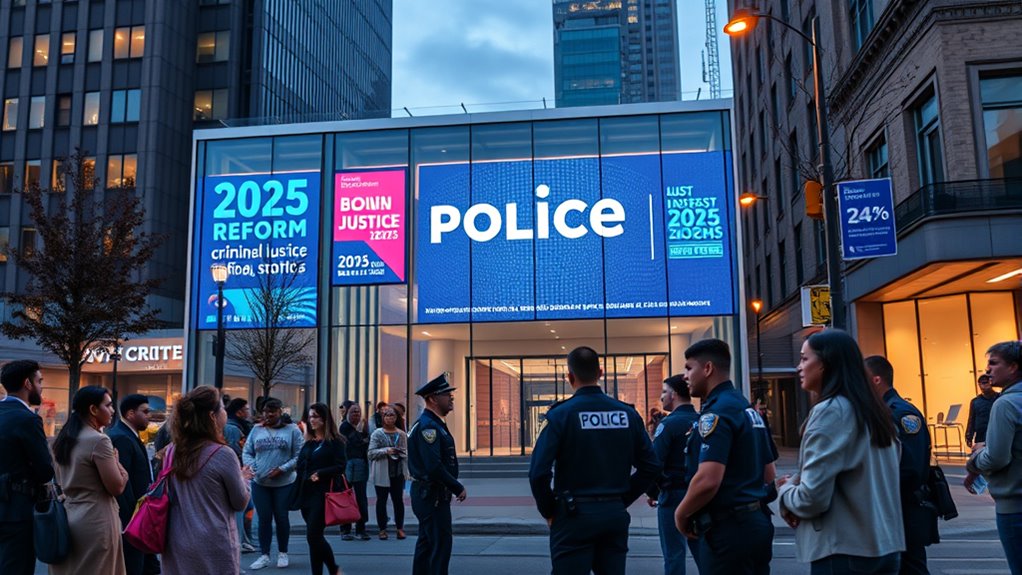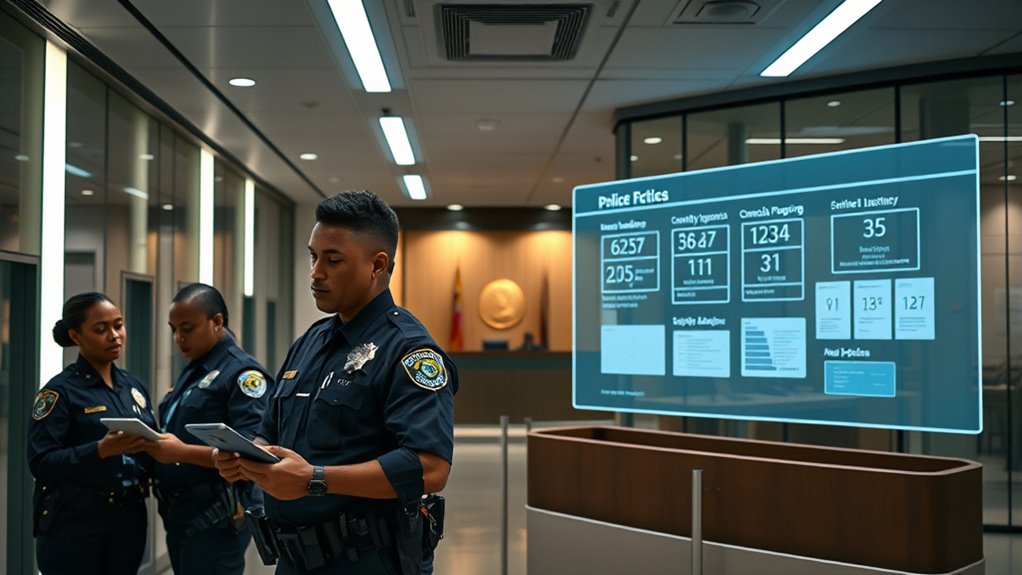In 2025, policing and criminal justice reforms focus on transparency and community engagement. Many officers now wear body cameras during all interactions, helping to build trust and reduce misconduct. Police departments emphasize community policing, fostering strong relationships with residents and working together to solve problems. These changes aim to make law enforcement more accountable and approachable. To learn how these initiatives are shaping the future of justice, keep exploring the latest developments.
Key Takeaways
- Widespread use of body cameras enhances transparency and accountability in police interactions, reducing misconduct.
- Community policing strategies foster trust, collaboration, and proactive problem-solving between officers and residents.
- Technology improvements address storage, access, and activation issues, strengthening footage security and policy compliance.
- Criminal justice reforms focus on community engagement, reducing biases, and implementing alternatives to incarceration.
- Overall, policing in 2025 emphasizes transparency, community partnership, and technological advancements to promote fairer law enforcement.

Have you ever wondered whether our current policing practices truly serve justice? In 2025, that question remains at the forefront of public debate, especially as communities push for reforms to build trust and accountability. One notable development is the increased use of body cameras by law enforcement officers. These devices are designed to provide an objective record of interactions between police and the public, helping to reduce instances of misconduct and false accusations. When officers activate their body cameras, you can see a real-time account of events, which often clarifies misunderstandings and promotes transparency. Many departments have adopted policies requiring officers to wear cameras during all interactions, from routine traffic stops to high-stakes encounters. The hope is that this technology not only discourages inappropriate behavior but also reassures communities that officers are acting ethically. However, challenges remain—questions about when cameras are turned on, how footage is stored, and who has access continue to spark debate. Still, the widespread deployment of body cameras signals a shift toward greater accountability and a recognition that technology can play a crucial role in reform efforts. Furthermore, ongoing advancements in camera technology are likely to enhance the quality and security of footage, further supporting reform initiatives.
Alongside technological advancements, community policing has gained renewed importance in the conversation about justice. Instead of relying solely on traditional enforcement methods, police departments are increasingly engaging with residents to build mutual trust. Community policing emphasizes proactive problem-solving and establishing long-term relationships with neighborhood members. It involves officers participating in local events, attending neighborhood meetings, and working collaboratively with community groups to identify and address issues before they escalate. When you see police officers walking the beat or organizing neighborhood cleanups, you’re witnessing a shift toward a more approachable, community-centered approach to law enforcement. This strategy aims to reduce crime, but more importantly, it fosters understanding and respect between officers and residents. By being visible and accessible, officers can dispel stereotypes, address concerns directly, and develop solutions tailored to each community’s unique needs. While not a quick fix, community policing helps lay the groundwork for lasting change, encouraging residents to see the police as allies rather than adversaries. In principle, it promotes a model of policing rooted in collaboration, transparency, and shared responsibility—an essential component of ongoing reforms.
In 2025, these initiatives—use of body cameras and community policing—are shaping a new landscape for law enforcement, one that aspires to be more transparent, accountable, and community-oriented. Both strategies reflect a recognition that reform requires more than policies on paper; it demands genuine engagement and technological support to rebuild trust. As you observe these changes, it becomes clear that the path toward justice involves continuous adaptation, listening to community voices, and leveraging innovations that make policing fairer and more effective.
Frequently Asked Questions
How Have Community-Led Policing Initiatives Evolved Recently?
Community-led policing initiatives have recently evolved by emphasizing stronger community engagement and enhanced police accountability. You see more programs that involve residents directly in decision-making, fostering trust and transparency. These efforts include neighborhood councils, public forums, and collaborative problem-solving. Officers now prioritize building relationships over enforcement, which helps address local concerns more effectively. As a result, communities feel more involved and confident that their voices influence policing practices.
What New Technologies Are Shaping Law Enforcement Practices in 2025?
Imagine law enforcement as a high-tech chess game, where AI surveillance and predictive analytics are your most advanced moves. In 2025, these tools sharpen officers’ instincts, helping them anticipate crimes before they happen. AI surveillance offers eyes everywhere, while predictive analytics act as a crystal ball, guiding decisions. Together, they transform policing into a vigilant, data-driven force, making communities safer with smarter, faster responses.
How Effective Have Recent Criminal Justice Reforms Been Across States?
You’ll notice that recent criminal justice reforms across states have had mixed results. Crime statistics in some areas show a decline, suggesting reforms like sentencing reforms are working. However, in other regions, crime rates remain steady or increase, indicating that reforms alone aren’t enough. You should consider that ongoing adjustments are vital to address local challenges and guarantee reforms lead to safer communities effectively.
What Are the Key Challenges in Implementing Nationwide Reform Policies?
You face key challenges like funding constraints and political opposition when implementing nationwide reform policies. Limited resources make it hard to expand programs or train officers adequately, while political disagreements stall progress. You might also encounter resistance from stakeholders wary of change or concerned about costs. Overcoming these obstacles requires building broad consensus, securing sustainable funding, and demonstrating the long-term benefits of reform to gain widespread support.
How Has Public Perception of Law Enforcement Changed Since 2023?
Since 2023, your perception of law enforcement has shifted, influenced heavily by media coverage and public trust concerns. You might notice more skepticism due to increased scrutiny of police actions, yet some feel hopeful as reforms improve transparency. Media influence plays a vital role in shaping opinions, often highlighting both progress and setbacks. Overall, your view reflects a complex mix of cautious optimism and ongoing doubts about law enforcement’s accountability and effectiveness.
Conclusion
As you look ahead to 2025, remember that reform is a journey, not a destination. While progress may feel like a slow burn, every step forward adds fuel to change. Keep pushing for transparency, accountability, and fairness—like planting seeds for a brighter future. Change is the tide, and with collective effort, you can help steer it toward justice and equality. Together, you’re shaping a system that truly serves everyone.








